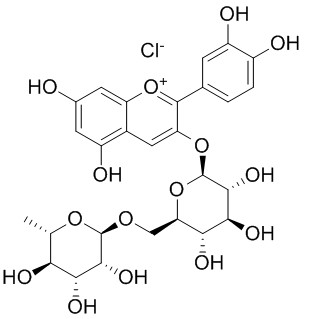Cyanidin-3-O-rutinoside chloride
Cyanidin-3-O-rutinoside chloride has antioxidant activity. It has LPO inhibition at a 0.25 μM concentration, inhibits the COX-1 enzyme by 45.2 and COX-2 by 61.5 at 5 μM. Cyanidin-3-O-rutinoside chloride improves vision in humans (for night blindness).
Inquire / Order:
manager@chemfaces.com
Technical Inquiries:
service@chemfaces.com
Tel:
+86-27-84237783
Fax:
+86-27-84254680
Address:
1 Building, No. 83, CheCheng Rd., Wuhan Economic and Technological Development Zone, Wuhan, Hubei 430056, PRC
Providing storage is as stated on the product vial and the vial is kept tightly sealed, the product can be stored for up to
24 months(2-8C).
Wherever possible, you should prepare and use solutions on the same day. However, if you need to make up stock solutions in advance, we recommend that you store the solution as aliquots in tightly sealed vials at -20C. Generally, these will be useable for up to two weeks. Before use, and prior to opening the vial we recommend that you allow your product to equilibrate to room temperature for at least 1 hour.
Need more advice on solubility, usage and handling? Please email to: service@chemfaces.com
The packaging of the product may have turned upside down during transportation, resulting in the natural compounds adhering to the neck or cap of the vial. take the vial out of its packaging and gently shake to let the compounds fall to the bottom of the vial. for liquid products, centrifuge at 200-500 RPM to gather the liquid at the bottom of the vial. try to avoid loss or contamination during handling.
Cancer Sci.2022, 113(4):1406-1416.
Int J Mol Sci.2019, 21(1):E265
J Pharm Biomed Anal.2021, 196:113931.
Antioxidants (Basel).2021, 10(9):1487.
United States Patent Application2020, 20200038363
Pharmacia2022, 69(3): 883-890.
Antioxidants (Basel).2020, 9(7):581.
J. Traditional Thai Medical Res. 2022,8(1):1-14.
Phytother Res.2018, 32(12):2551-2559
LWT-Food Science and Technology2017, 75:488-496
Related and Featured Products
Food Chem . 2011 Dec 1;129(3):1100-7.
Interaction between gliadins and anthocyan derivatives[Pubmed:
25212343]
Abstract
The interaction of gliadins with some anthocyanins (e.g. myrtillin, malvin, keracyanin, callistephin) and anthocyanidins (e.g. delphinidin, pelargonidin, cyanidin) has been analysed in aqueous solution at pH condition of the stomach, in which these compounds are initially metabolized. NMR, FT-IR and UV-Vis spectroscopic methods have been employed to determine the anthocyanin binding mode. The spectroscopic data seem to indicate that anthocyans are located along the polypeptide chains of gliadins in a generical molecular interaction between the two moieties. Our data do not exclude that hydrogen bonding interaction too is operating. Anthocyan-gliadins complexes are very soluble in acidic conditions. The results provide new insights into anthocyan-protein interaction and may have relevance to human health.
Keywords: Anthocyanins; Gliadins; Interaction; Spectroscopy.
J Agric Food Chem . 2004 Sep 8;52(18):5759-63.
Inhibition of malonaldehyde formation in oxidized calf thymus DNA with synthetic and natural antioxidants[Pubmed:
15373421]
Abstract
Calf thymus DNA was oxidized by Fenton's reagent with or without synthetic antioxidants (Trolox and DMPO) and natural antioxidants-quercetin, apigenin, 2''-O-glycosylisovitexin (2''-O-GIV), (+)-catechin, cyanidin, pelargonidin, keracyanin, and callistephin. Malonaldehyde (MA) formed in oxidized DNA was analyzed using gas chromatography. MA formed from oxidized DNA without antioxidants was 4.0 +/- 0.53 nmol/mg of DNA in buffer solution, 3.7 +/- 0.34 nmol/mg of DNA in NaOH solution, and 4.6 +/- 0.19 nmol/mg of DNA in HCl solution. MA formed from DNA with antioxidants (at the level of 0.1 micromol/mL) ranged from 1.90 +/- 0.18 (catechin) to 4.10 +/- 0.18 nmol/mg of DNA (cyanidin). Trolox and DMPO inhibited MA formation from DNA by 41.2% and 18.6%, respectively, at the level of 0.1 micromol/mL. Trolox (water-soluble vitamin E) exhibited dose-dependent inhibition. The decreasing order of inhibitory effect by flavonoids at the level of 0.1 micromol/mL was catechin (48.5%) > quercetin (47.1%) > 2''-O-GIV (40.5%) > apigenin (29.9%) and by the anthocyanins at the level of 0.1 micromol/mL was callistephin (45%) > keracyanin (33.2%) > pelargonidin (25.1%) > cyanidin (10.2%).



